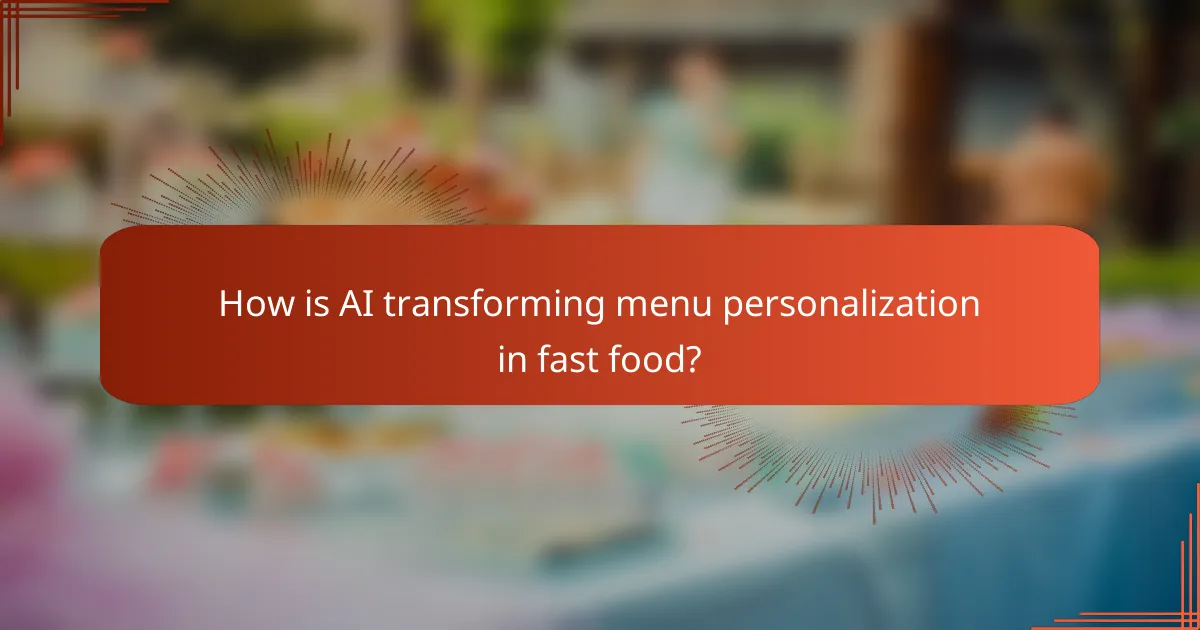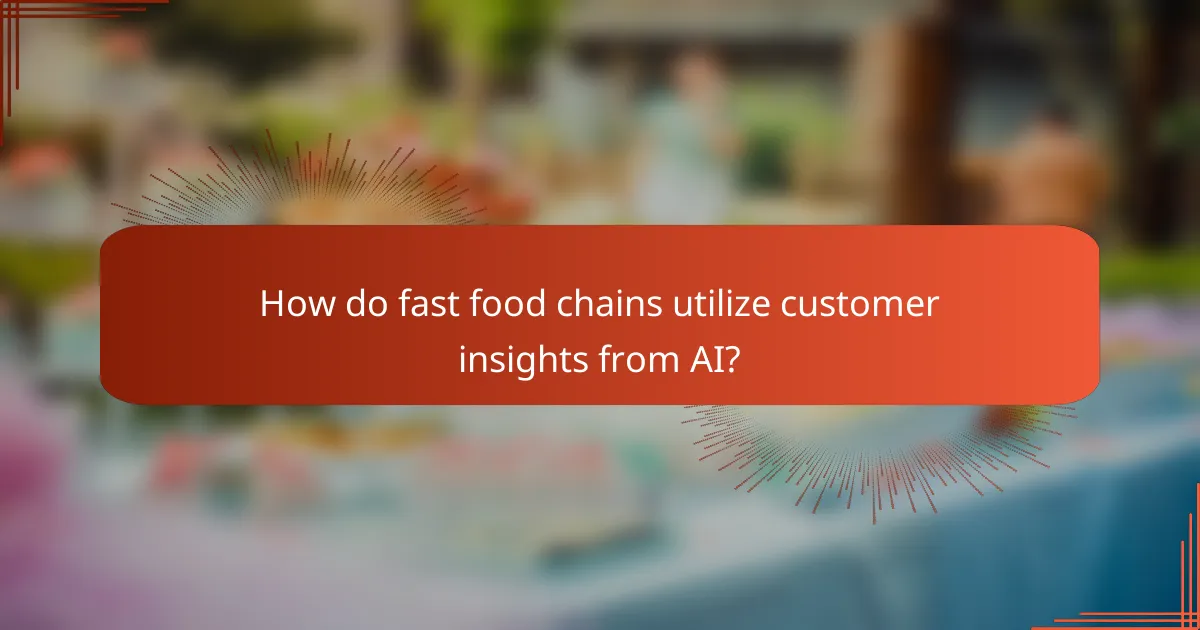AI is transforming the fast food industry by enabling menu personalization through advanced data analytics that cater to individual customer preferences. This technology not only allows restaurants to adapt their offerings in real-time but also provides critical insights into consumer trends, helping businesses stay competitive and enhance customer satisfaction.

How is AI transforming menu personalization in fast food?
AI is revolutionizing menu personalization in fast food by leveraging data analytics to tailor offerings based on customer preferences and behaviors. This technology enables restaurants to dynamically adjust their menus, track individual tastes, and create localized options that resonate with specific markets.
Dynamic menu adjustments
Dynamic menu adjustments allow fast food chains to modify their offerings in real-time based on various factors such as time of day, seasonality, and customer demand. For instance, a restaurant might promote breakfast items during morning hours and switch to lunch specials as the day progresses. This flexibility helps maximize sales and enhance customer satisfaction.
To implement dynamic adjustments effectively, restaurants can utilize AI algorithms that analyze sales data and customer interactions. By identifying trends, they can predict which items are likely to be popular at different times, ensuring that the menu aligns with customer expectations.
Customer preference tracking
Customer preference tracking involves collecting and analyzing data on individual purchasing habits to offer personalized recommendations. Fast food chains can use loyalty programs and mobile apps to gather insights into what customers order most frequently, allowing them to tailor promotions and suggest items that align with those preferences.
For example, if a customer regularly orders spicy items, the system can highlight new spicy menu additions or offer discounts on those items. This targeted approach not only enhances the customer experience but also encourages repeat business.
Localized offerings
Localized offerings refer to menu items that are specifically designed to cater to regional tastes and cultural preferences. AI can analyze demographic data and local trends to identify which flavors or ingredients resonate with customers in different areas. This strategy helps fast food brands connect with their audience on a deeper level.
For instance, a chain might introduce a unique burger featuring local ingredients or flavors that are popular in a specific country or region. By doing so, they can attract more customers and foster brand loyalty, as consumers appreciate options that reflect their culinary preferences.

What are the benefits of AI in trend analysis for fast food?
AI in trend analysis for fast food provides valuable insights that help businesses adapt to changing consumer preferences and market dynamics. By leveraging data, fast food chains can optimize their offerings, enhance customer satisfaction, and improve operational efficiency.
Real-time data insights
Real-time data insights enable fast food businesses to monitor customer behavior and preferences as they happen. This allows for immediate adjustments in menu offerings or promotional strategies based on current trends. For instance, if a particular item is gaining popularity, restaurants can increase its availability or promote it more heavily.
Utilizing AI tools, companies can analyze data from various sources, including social media, sales transactions, and customer feedback. This comprehensive view helps identify emerging trends quickly, ensuring that businesses stay ahead of the competition.
Predictive analytics for sales
Predictive analytics uses historical data to forecast future sales trends, helping fast food chains make informed decisions about inventory and staffing. By understanding seasonal patterns or the impact of local events, businesses can better prepare for fluctuations in demand.
For example, if data shows that sales typically spike during summer months, restaurants can adjust their staffing levels and stock accordingly. This proactive approach minimizes waste and maximizes profitability.
Competitive benchmarking
Competitive benchmarking involves comparing a fast food chain’s performance against its competitors to identify strengths and weaknesses. AI can analyze market data to provide insights into how a business stacks up in terms of menu offerings, pricing, and customer satisfaction.
By understanding where they stand in relation to competitors, fast food businesses can refine their strategies. For instance, if a competitor is excelling in a specific product category, a chain might consider innovating or enhancing its own offerings to attract more customers.

How do fast food chains utilize customer insights from AI?
Fast food chains leverage customer insights from AI to enhance their offerings and improve customer experiences. By analyzing data on customer preferences and behaviors, these chains can tailor their menus, marketing strategies, and overall engagement efforts.
Enhanced customer engagement
AI-driven insights allow fast food chains to create personalized experiences for customers, increasing engagement. For instance, through mobile apps, customers can receive tailored promotions based on their previous orders or preferences, encouraging repeat visits.
Additionally, chatbots powered by AI can provide instant responses to customer inquiries, enhancing interaction and satisfaction. This level of engagement helps build loyalty, as customers feel valued and understood.
Targeted marketing strategies
Fast food chains use AI to analyze customer data and segment their audience effectively. This enables them to develop targeted marketing campaigns that resonate with specific demographics, such as age groups or dietary preferences.
For example, a chain might promote healthier menu options to health-conscious customers while offering discounts on popular items to families. By tailoring marketing efforts, chains can improve conversion rates and maximize their advertising budgets.
Feedback loop integration
Integrating customer feedback into AI systems allows fast food chains to continuously refine their offerings. By analyzing reviews and survey responses, chains can identify trends and areas for improvement in their menu or service.
Establishing a feedback loop ensures that customer insights are not only collected but also acted upon. This could involve adjusting menu items based on popularity or addressing service issues promptly, ultimately leading to a better customer experience.

What technologies support AI in fast food?
AI in fast food is supported by various technologies that enhance menu personalization, trend analysis, and customer insights. Key technologies include machine learning algorithms, natural language processing, and data analytics platforms, each playing a crucial role in optimizing operations and improving customer experiences.
Machine learning algorithms
Machine learning algorithms analyze vast amounts of data to identify patterns and predict customer preferences. These algorithms can segment customers based on their purchasing behavior, allowing fast food chains to tailor promotions and menu items effectively. For instance, a restaurant might use these algorithms to recommend meals based on a customer’s previous orders.
When implementing machine learning, it’s essential to ensure data quality and relevance. Poor data can lead to inaccurate predictions, which may frustrate customers rather than enhance their experience. Regularly updating the models with new data helps maintain their effectiveness.
Natural language processing
Natural language processing (NLP) enables fast food businesses to understand and respond to customer inquiries and feedback more effectively. By analyzing customer reviews and social media comments, NLP can uncover insights about customer sentiment and preferences. This technology can also power chatbots that assist customers in placing orders or answering questions.
To maximize the benefits of NLP, companies should focus on training their models with diverse datasets that reflect their customer base. This approach helps ensure that the system can accurately interpret various dialects and terminologies, enhancing customer interactions.
Data analytics platforms
Data analytics platforms aggregate and analyze data from multiple sources, providing fast food chains with actionable insights. These platforms can track sales trends, customer demographics, and inventory levels, helping businesses make informed decisions about menu offerings and pricing strategies. For example, a chain might discover that certain items sell better during specific times of the year, prompting seasonal promotions.
When choosing a data analytics platform, consider factors such as ease of use, integration capabilities, and scalability. A user-friendly interface allows staff to access insights quickly, while integration with existing systems ensures a seamless flow of information. Regularly reviewing analytics can help identify emerging trends and adjust strategies accordingly.

What are the challenges of implementing AI in fast food?
Implementing AI in fast food presents several challenges, including data privacy concerns, integration with existing systems, and the need for staff training. Addressing these issues is crucial for successful AI adoption and maximizing its benefits.
Data privacy concerns
Data privacy is a significant challenge when implementing AI in fast food. Collecting and analyzing customer data can lead to potential breaches of privacy, especially with regulations like GDPR in Europe and CCPA in California. Fast food chains must ensure they comply with these regulations while building customer trust.
To mitigate privacy risks, businesses should adopt transparent data practices, such as informing customers about data usage and obtaining explicit consent. Regular audits and security measures can further protect sensitive information.
Integration with existing systems
Integrating AI solutions with current systems can be complex and resource-intensive. Many fast food establishments rely on legacy systems that may not be compatible with modern AI technologies. This can lead to increased costs and extended timelines for implementation.
To streamline integration, businesses should evaluate their existing infrastructure and consider modular AI solutions that can work alongside current systems. Collaborating with technology partners who understand the fast food industry can also facilitate smoother transitions.
Staff training requirements
Staff training is essential for the successful implementation of AI in fast food. Employees need to understand how to use AI tools effectively and adapt to new workflows. Insufficient training can result in underutilization of AI capabilities and decreased operational efficiency.
Companies should develop comprehensive training programs that cover both technical skills and the benefits of AI. Ongoing support and resources can help staff stay updated on new technologies and best practices, ensuring a smoother transition to AI-enhanced operations.



